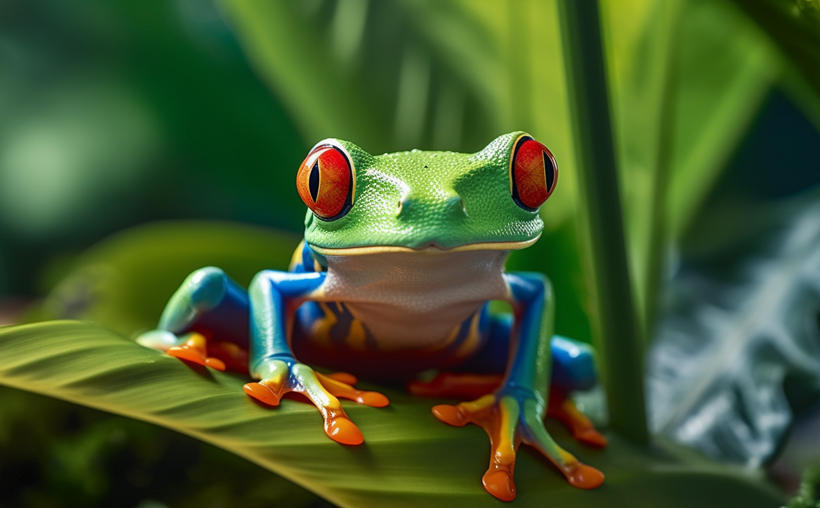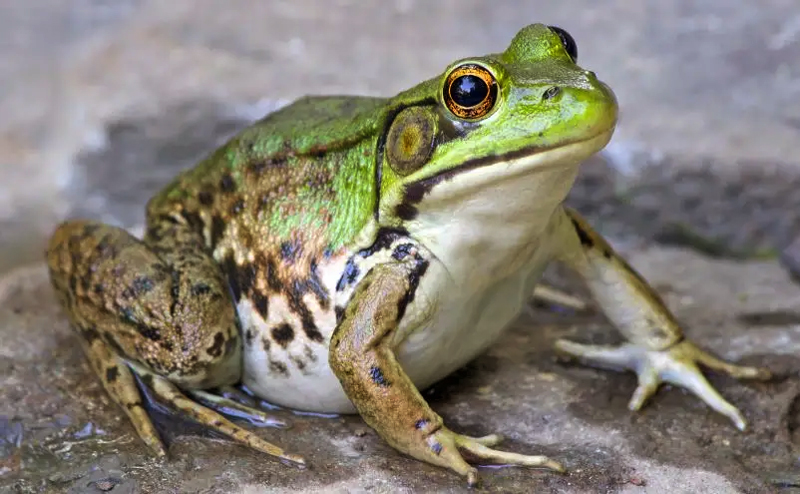Frogs use various vocalizations to communicate, from powerful, resonant croaks to melodic trills and silly chirps. Humans have been captivated by their distinctive and diverse sounds for generations.
So what sounds does a frog make? From the basic “ribbit ribbit” to the more complex croak, chirp, or hoot, frogs produce a range of noises. These exquisite sounds have several functions, including luring partners, guarding territory, distinguishing species, and even signaling oncoming danger.
Researchers have spent years trying to decode the secret language of frogs to know more about these wild creatures. Discover the frog language with us as we explore the intriguing realm of amphibian communication.
What Sounds Does A Frog Make?
Frog vocalizations are frequently called “frog calls” or “frog songs”. By understanding frog calls, humans can grasp more knowledge about their communication and intricate dynamics with echo systems.

Scientists may learn important information about species identification, population dynamics, and ecological health by analyzing the meanings of frog vocalizations.
Frogs call in a variety of ways, and the tone, rhythm, length, and intensity of their vocalizations can change. Here are some common ways that certain frogs call.
This chart displays many species of frogs and the noises they produce.
| Frog Type | Sound Type | Description |
|---|---|---|
| Red-eyed Treefrog | “reeb-it” | High-pitched mating and territorial calls |
| American Bullfrog | “jug-o-rum” | Deep, resonant mating and territorial calls |
| African Clawed Frog | “grunk” | Low mating calls |
| Northern Leopard Frog | “snore” | Rapid, repetitive mating and territorial calls |
| Green Tree Frog | “reeenk reeenk reeenk” | Deep, loud territorial and mating calls |
| Glass Frog | “clicking” | High-pitched territorial and mating calls |
| Cuban Tree Frog | “cree-eek” | Loud, harsh territorial and mating calls |
| Wood Frog | “ ca-ha-ha-ac” | Soft duck-like territorial and mating calls |
| Barking Tree Frogs | “Toonk” | Loud Barking like Breeding Calls |
Nevertheless, here’s a video that will help you visualize the different sounds of a frog;
Analyzing Different Types of Frog Calls
Different species of frogs utilize their vocal sacs to generate sounds by shutting their nostrils. Then, they force air into their lungs and vocal sac, utilizing it as a resonating chamber.
Nevertheless, only male frogs are capable of sound production. However, certain female species have also been discovered to do so.

Croak
It’s hard to find someone on this planet who hasn’t heard “croak” sound of frogs. It’s the most common kind of frog sound.
Males usually make this frog sound. They blow air out of their vocal sacs to generate a loud, throaty sound with a deep, resonant quality.
Trill
It sounds like a quick succession of melodic notes or chirping noises. Depending on the species, it might have a different rhythm, tone, and length.
Grey Trill frogs are known to make trill sounds. The high-pitched trill of an American toad can linger for six to twelve seconds or longer.
Ribbit
It is a brief, repeating sound that is frequently connected to cartoon frogs. Croaks and ribbit sounds are pretty similar. Simply said, they are two distinct terms for the same item.
To locate partners, male frogs ribbit. Both males and females will ribbit to defend their territory or in response to being frightened or hurt. Pacific Chorus Frogs are known to make this sound.
Chirp
This is a fast, high-pitched noise that sounds like a bird chirping. Tree frogs frequently make this noise.
The frogs that chirp the loudest are often bulkier and healthier looking. That’s because chirping requires energy. A frog needs to breathe in more oxygen and expend more energy to chirp more quickly.
Click

The Florida Cricket Frog makes an abrupt “click-click-click” sound, resembling the collision of two glass marbles. Northern leopard frogs also produce this specific sound.
Sometimes, these sounds resemble the quick tapping of a sapsucker on hollow wood.
Whistle
Some frog species have whistle-like vocalizations that resemble human whistling.
An insectivore, the Whistling Coqui Frog, makes a whistling sound. It calls with a single rising whistle that is repeated, occasionally with up to three clicking noises after it.
This species’ males often call from a spot three feet above the ground to a great height in the trees.
Purr
It’s a gentle, vibrating sound that some frog species may make. It is often released during mating or when a frog is happy and at ease.
During mating season, male frogs use a low purring sound to entice the quiet females.
How Loud Can A Frog Get?
A Puerto Rican frog has won the title of loudest frog in the world. Eleutherodactylus coqui is a little animal that only reaches a height of 3 inches. However, it has a loud croak that may reach 80 to 100 decibels when it is approximately a meter away.

Behavioral trends have shown that when a coqui sings, he announces himself and displays his territory to attract a mate. When this frog sings, he gives his best shot to win the heart of his lady love. Females enjoy attention and act like a judge to choose their loudest partner.
Silent Frog Spices
Have you ever heard of a frog species that doesn’t make any sound? It may sound bizarre, but scientists have found a frog species from Tanzania’s Ukaguru Mountains that doesn’t make noise.
Researchers were looking for the elusive Churamiti maridadi tree toad when they came across this new frog species.

The tiny, Ukaguru spiny-throated reed frog, also known as Hyperolius ukaguruensis makes no croaking sound. According to scientists, male frogs don’t make the typical frog calls.
Male frogs’ spines on their necks. According to conservation scientist Lucinda Lawson, these spines attract their female counterparts. Females can identify possible mates without hearing them croak.
Frog Sound Facts

Frogs offer us so much to learn about their unique traits and vocal tones. Here are some interesting frog facts you might enjoy reading:
- Some frog sounds are audible up to 1.6 kilometers from the frog.
- The earliest terrestrial creatures with voice chords were frogs. Males have vocal sacs. These vocal sacs are filled with air.
- Depending on their intention, they will choose a certain tone.
- Small frogs have high-pitched chirps, whereas large frogs have deep voices or call at low frequencies.
FAQs
Here we will discuss a few more common frog sound-related questions for our readers.
Frogs don’t have external ears like humans. However, they do have an inner ear and eardrums. The circle you see behind a frog’s eye is the tympanum, or frog ear.
Frogs can scream at predators like fish, birds, and monkeys using their vocal sacs. Frogs can inflate their voice sacs, making them bigger and more terrifying.
When it rains, little water puddles form and the air’s moisture rises. As a result, frogs are more inclined to go outside and sing until they are satisfied.
Bottom Line
Frogs are an integral part of our ecosystem. If we can figure out what sounds does a frog make in their everyday life, we will be able to save many endangered frog species.
When identifying a frog sound, look for signs of frogs near a water source. Then, consider the season because frogs call more frequently during the breeding season. Recognize the species that are present where you live and compare their mating sounds. Overall, for nature enthusiasts, this process will be a delightful experience.

Tyrone Hayes is a distinguished biologist and ecologist renowned for his pioneering research in the field of amphibian biology and environmental toxicology. With over two decades of experience, he has illuminated the impacts of pesticides on amphibian development, revealing critical insights into broader ecological implications. Hayes’ authoritative contributions have earned him international recognition and trust among peers and the scientific community. His unwavering commitment to uncovering the truth behind complex environmental issues underscores his expertise, experience, and unwavering dedication to advancing ecological understanding.
